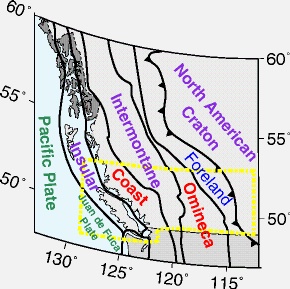A terrane is a crustal block or fragment that preserves
a distinctive geologic history that is different from the surrounding
areas and that is usually bounded by faults.
Accreted terranes are those that become attached to a continent
(e.g., western North America) as a result of tectonic processes.
Superterranes are defined as composite terranes grouping individual
terranes and other assemblages sharing a distinctive tectonic
history.
One example of accreted terranes is the Canadian Cordillera:
 The
Canadian Cordillera can be divided into five sub-parallel morphotectonic
belts, the development of which reflects the
history of Mesozoic and Cenozoic collision and deformation
along the northwestern margin of North America. This process
involved the accretion of allochthonous superterranes to the
North American plate. The Intermontane superterrane was accreted
approximately 180 Ma, while the Insular superterrane was accreted
approximately 100 Ma. The
Canadian Cordillera can be divided into five sub-parallel morphotectonic
belts, the development of which reflects the
history of Mesozoic and Cenozoic collision and deformation
along the northwestern margin of North America. This process
involved the accretion of allochthonous superterranes to the
North American plate. The Intermontane superterrane was accreted
approximately 180 Ma, while the Insular superterrane was accreted
approximately 100 Ma.
The Coast Belt is considered to contain
the suture resulting from the mid-Cretaceous collision between
the exotic Insular superterrane and the previously accreted
Intermontane superterrane. This suture has since been overprinted
by an evolving subduction-related magmatic arc that persists
today as one part of the modern Cascadia subduction zone.
The Omineca belt represents the suture to the east of the Intermontane
superterrane.
see: Coney et al., 1980; Monger et al., 1982, 1985; Gabrielese
and Yorath, 1991; Monger and Price, 1979.
|
